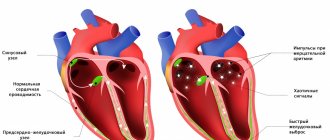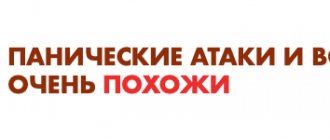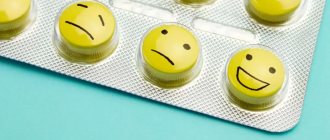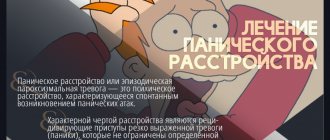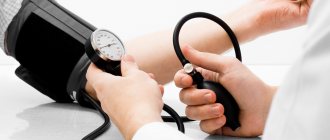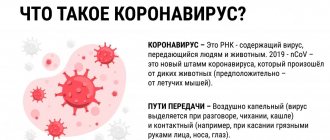What is a panic attack
A panic attack is an attack of sudden fear and severe anxiety for no apparent reason.
The origins of panic disorder are not completely clear. However, it is believed that the disease has a genetic predisposition and more often affects the fair sex. Women are more prone to panic attacks and suffer from this disorder 2-3 times more often than men. Panic attacks cannot lead to death, despite the fact that this is the feeling that most often accompanies them. The more often attacks occur, the worse the quality of life becomes. People who have repeatedly experienced panic attacks become increasingly anxious and subconsciously try to avoid places or situations where and when they succumbed to fear. Those who have at least once experienced an attack at night subsequently experience sleep disorders.
Diagnostic methods
For effective treatment, it is important to determine the exact cause of the headache and facial area. It is impossible to carry out diagnosis on your own, since it requires the use of precise equipment and laboratory tests. The complex may include the following activities:
- blood tests - prescribed to determine inflammatory processes, bacterial infections and various diseases of the heart and blood vessels;
- X-ray is one of the examination methods for suspected diseases of the teeth and temporomandibular joint;
- MRI, CT scan of the brain;
- ophthalmological examinations aimed at diagnosing vision and measuring intraocular pressure;
- assessment of the condition and conductivity of the vessels of the neck and head - carried out by radiography using a contrast agent.
The Clinical Brain Institute offers headache diagnostic programs. The set of measures is selected individually, based on the results of the inspection. To obtain accurate data, it is important to notify the doctor about all conditions for the occurrence of pain, their nature and intensity, and also undergo the prescribed examinations.
What to do in case of a panic attack
The most important thing to do during a panic attack is to switch your attention. Any method is suitable for distraction. If an attack occurs in a public place, you can clench and unclench your fists, rub your earlobes, or shift from foot to foot. If panic takes you by surprise at home, try turning on music and starting to do household chores: washing dishes, dusting. Any activity that involves muscle work and requires attention is suitable.
Since a panic attack is accompanied by a rapid heartbeat and a feeling of stuffiness, it would be a good idea to take a couple of sips of water and concentrate on breathing. It is best to master several techniques that will quickly relieve tension. In case of an attack, start by exhaling - slow it down, and the pulse will also slow down. The ratio of the length of inhalation and exhalation should be 1:2. You can experiment and choose the technique that will help you. A smartphone can also help you take your mind off panic. Games, social networks - all this will shift attention and distract from a panic attack.
Prevention methods
Timely prevention is the key to good health at any age. It is important to form the right habits that will have a positive effect on the health of the heart and blood vessels, teeth and other organs. Doctors recommend:
- eat right, get enough vitamins and microelements;
- give up bad habits - smoking and drinking alcohol affect the condition of blood vessels;
- normalize your daily routine and devote enough time to rest;
- carry out moderate physical activity to train the heart muscle.
At the Clinical Brain Institute you can undergo an accurate and high-quality diagnosis of headaches and pain in the face. There is modern equipment here that can be used to determine the causes of pain. Doctors will also select an effective treatment regimen for use at home or in the hospital of our center.
Clinical Brain Institute Rating: 5/5 — 1 votes
Share article on social networks
How is normal anxiety different from a panic attack?
The mechanism that triggers a panic attack is no different from what causes ordinary anxiety - both are psychophysical reactions to danger. The difference is that a panic attack is a reaction to danger in the absence of danger. However, a false alarm triggers the same cascade of reactions as a normal alarm - the sympathetic system is activated, and adrenaline is released.
A panic attack can occur due to excessive physical activity, fatigue and exhaustion, as well as due to the abuse of stimulants and alcohol. In addition, stress and unresolved conflict situations can trigger an attack. A lack of understanding of one's own experiences and feelings, a tendency to avoid and ignore negative emotions also increase vulnerability to panic disorder.
Treatment of headaches and facial pain
The treatment regimen for headaches and pain in the face is selected individually. It will include measures to eliminate the underlying disease, as well as to relieve symptoms. Based on the diagnostic results, the doctor may prescribe the following methods:
- drug treatment - may include anti-inflammatory and painkillers, antibiotics, drugs to improve cerebral circulation;
- physiotherapy – carried out to stimulate blood circulation and innervation in the face and head;
- diet for blood vessels - includes simple foods, with a minimum amount of fried foods, animal fats, fast food and spices;
- surgical intervention - most often prescribed for mechanical compression of nerves and blood vessels, in the presence of neoplasms and dental diseases, as well as for clearing the contents of the paranasal sinuses.
Doctors at the Clinical Institute of the Brain will select appropriate treatment tactics based on the results of a general examination. For most patients, it is enough to take medications, follow a diet and adjust their daily routine to improve their health. However, for some diseases surgical intervention is indicated.
How to treat panic attacks and when to see a specialist
It is necessary to contact a specialist if you have recurring panic attacks. Therapy is selected individually and, as a rule, includes psychotherapeutic work and drug therapy. Psychotherapy involves various techniques aimed at recognizing and understanding the causes of problems, teaching ways to deal with the symptoms of the disease, and relaxation methods. Psychotherapy can take place in the form of individual meetings with a psychotherapist or in the form of group sessions with other patients. Drug therapy for panic disorder is carried out with various drugs that help reduce the level of anxiety and fear. Prescription, dosage adjustment and discontinuation of treatment must be carried out under the supervision of a physician.
Modern neurotechnologies can also help in the treatment of panic attacks. Methods of neurofeedback training have been developed for patients with panic disorder. During the trainings, patients learn to manage their emotional state, they form new neural connections, and their anxiety level decreases. In addition to professional help, lifestyle plays a significant role in the treatment and prevention of panic attacks. Try not to abuse alcohol and caffeine, get more rest, go in for sports, preferably yoga.
Source: https://www.wmj.ru/krasota/telo/golovokruzhenie-zhar-i-dazhe-udushe-simptomy-panicheskikh-atak-i-kak-s-nimi-borotsya-razbiraem-s-vrachom.htm
Back to list
Causes of hot flashes to the head
Physiological factors
A feeling of heat and a rush of blood to the head occurs during intense physical activity, especially in untrained people with excess body weight.
There is a feeling that your face is on fire. The skin becomes noticeably red and very warm to the touch. Hot flashes are accompanied by a feeling of fullness and heaviness in the head, and sometimes there is tinnitus. Unpleasant sensations disappear 10-20 minutes after rest. Hot flashes to the head are observed with psycho-emotional stress, severe anxiety, and shame. A person feels his face flush and his skin becomes hot. Sometimes an unpleasant pulsation in the head and discomfort in the stomach develop. This condition occurs periodically in any person, but frequent repetition of attacks, combined with the fear of blushing, may indicate erythrophobia.
Menopausal syndrome in women
Hormonal changes during menopause are the main etiological factor for hot flashes to the face and head in women. Attacks begin suddenly and are provoked by staying in a stuffy room, anxiety, or eating spicy or hot food. The woman feels an unpleasant heat and burning sensation in the head and neck. The skin very quickly turns pink or becomes covered with red spots. There is severe sweating of the face and neck, when sweat literally runs down the skin.
The feeling of heat is accompanied by headache, dizziness, a feeling of lack of air, and increased anxiety. After 5-15 minutes, the feeling that blood has rushed to the head disappears, but the redness may persist for a long time. Such paroxysms are observed from 5 to 20 or more times per day. The most intense and painful flushes of heat to the head occur at night, as a result of which patients suffer from insomnia.
Vegetative-vascular dystonia
Dysfunction of nervous regulation is characterized by a polymorphism of symptoms. VSD is often manifested by a rush of blood and heat to the head, and increased sweating in this area. In addition to these signs, patients experience dull pain in the temples and the back of the head, a feeling of a “pressing hoop” around the head, and dizziness. Hot flashes in the form of vegetative paroxysms occur with varying frequency, are provoked by emotional overstrain, but more often develop without visible factors.
Hot flashes to the head
Cardiovascular diseases
Sudden flashes of heat, accompanied by a severe headache and flashing spots before the eyes, are characteristic of a hypertensive crisis. Due to the expansion of superficial vessels, the skin of the face and upper half of the body turns red and becomes noticeably hot. Increased sweating is observed. Similar signs are typical for the neurovegetative form of hypertensive crisis.
Periodic redness, a feeling of vascular congestion and a rush to the head occur in hypertensive patients even with normal working pressure. Occasionally, attacks of facial redness with fever without fever occur with atherosclerosis. Such disorders are combined with headaches, dizziness, and tinnitus. Hot flashes are possible at any time of the day and are not associated with external provoking factors.
Complications of pharmacotherapy
Hot flashes in the head and neck are a side effect of taking nitrates to lower blood pressure. The symptom appears within a few minutes after rapid intravenous administration of drugs. The consequence of vasodilation is intense redness of the facial skin, patients feel fever and a throbbing headache. When trying to take a vertical position, dizziness and darkening of the eyes occur, caused by a sharp drop in blood pressure.
Rare causes
- Sleep pathologies
: sleep apnea syndrome, nightmares. - Withdrawal syndrome
: with alcoholic delirium, drug addiction. - Allergic reactions
: urticaria, Quincke's edema. - Damage to the central nervous system
: traumatic brain injury, neoplasms of the hypothalamic-pituitary system, post-concussion syndrome. - Endocrine disorders
: male menopause, diabetes mellitus, adrenal hyperfunction and pheochromocytoma.



